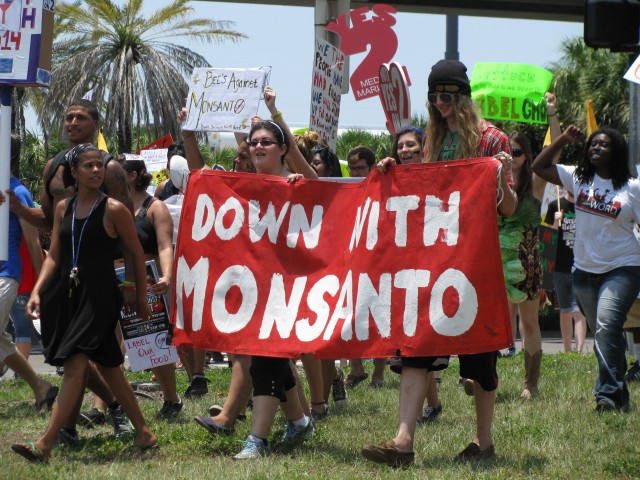Anita Stewart / Deep Green Resistance Florida

The latest news reports on glyphosate, the active ingredient in the popular weed-killer Roundup, indicate that it is present in California wines, Quaker Oats and even in the urine of elected officials in Europe. Roundup is manufactured by Monsanto ― the same Monsanto that produced Agent Orange (notoriously contaminated with dioxin) responsible for the ongoing, horrific birth defects in Viet Nam where it was widely used as a defoliant and sprayed from planes into the bush and over remote villages. These chemicals also affect the US children of those active duty military and veterans that were exposed. What is chilling is the fact that these chemicals have also been either stored or used here in the United States.
Agent Orange is connected to the 25% of Veterans testing positive for Diabetes 2 per the VA’s own website–the general population is at 8–10%. (As soon as you are diagnosed through the VA with Diabetes 2, the second question is “to your knowledge, were you ever exposed to Agent Orange?” So the VA is well aware of this connection).
The VA will not pay out any monies/disability to Agent Orange victims unless the veteran was stationed in Viet Nam. Per the veterans themselves and some of their most recent reports, Agent Orange was not used, stored or transported exclusively in Viet Nam.
The Risks are Supposed to be Secret on this Globe Full of Victims
50% of our general population will get cancer during their lifetime or have it already. And this directly affects all of us as many of us have loved ones with cancer or know someone that has died from it. Those of us who got our diagnosis already are working hard at staying alive. We will live the rest of our lives constantly detoxing. Some of us who are veterans have both cancer and diabetes and both conditions are connected to the use of Agent Orange and other Monsanto chemicals per the VA’s own website. We have probably been poisoned.
The important thing to note about these reports is that the IARC, a World Health Organization working group of doctors published their findings last year showing that Roundup’s Glyphosate “probably causes cancer.” Their report was posted on the LANCET website last year. Immediately after the report was published, Monsanto demanded a retraction of the IARC’s findings but they never got it.
From March Against Monsanto: “In a recent article by EcoWatch, it was revealed that the EPA had finally released its long-awaited report on the WHO declaration, only to mysteriously pull it from circulation.”
These are ways that corporate media, news outlets and government agencies censor, omit or create a critical buzz regarding information and attempt to keep it from those who need it most; like journalists, victims and medical workers. And of course to cover up the crimes by the corporations and any possibility of them being held accountable.
Other alarming trends and side effects of the regular use of these toxins include the killing off of our pollinators, such as bees, butterflies, and birds. Some of these populations are now collapsing. We are already losing approximately 200 species a day due to extinction. Without the pollinators, we will not be able to sustain our current food supplies.
Many questions need to be raised about the continued use of these toxins. Roundup is the one most widely used in the US, despite being banned in many other countries.
“This planet is Gaia because of her evolutionary adaptive capacity. The only question to ask is, ‘Will human beings be around in that adaptive context?’”
―Dr. Vandana Shiva, Eckerd College, March 9, 2015.
Our Demands and Why We March
Labeling GMOs or genetically modified organisms in our food products and produce is the other reason why we march. I believe at the very least companies should be accurately labeling them. March Against Monsanto calls for two events a year: in May and October. The events are to increase awareness about the need for labeling food that contains GMO’s. This would give the consumers all of the information they need to know so they can make educated choices for themselves and their families.
I want to take it a step further. I call for a permanent ban on Roundup and other similar agro-chemicals, and a boycott of anyone that is using them. We are literally marching for our lives. Who is with me?
Upcoming Events
We march everywhere on the globe Saturday, May 21st, 2016. Join us as we march for the right to not be poisoned anymore.
March Against Monsanto will be present at a hearing at the Hague in October 2016 to correspond with World Food Day. You can help crowdfund and organize that event.





